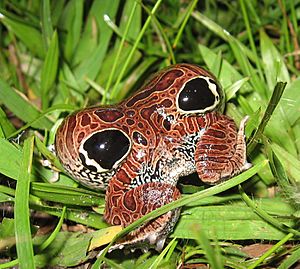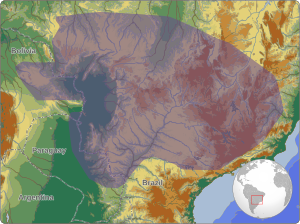Physalaemus nattereri facts for kids
Quick facts for kids Physalaemus nattereri |
|
|---|---|
 |
|
| Conservation status | |
| Scientific classification | |
 |
|
| Synonyms | |
|
The Physalaemus nattereri is a type of frog also known as the Cuyaba dwarf frog. You can find this frog in central and southeastern Brazil, and also in eastern Bolivia and Paraguay.
Contents
Cool Facts About the Cuyaba Dwarf Frog
This small frog has a special way to protect itself. It has two "false eyes" on its rear end. When it feels threatened, it lifts its rear to show these fake eyes. This can surprise animals that want to eat it.
If a predator isn't fooled by the eyespots, the frog has another trick. It can release a yucky liquid from glands in those eyespots. This unpleasant liquid helps to scare off attackers. These frogs are usually about 3 to 4 centimeters long.
Reproduction and Life Cycle
Physalaemus nattereri frogs are known for their "explosive breeding." This means that most of their mating happens very quickly, usually just a few days after heavy rain.
Male frogs will make loud calls to attract females. They might also actively search for a mate. The female frogs lay their eggs in temporary ponds. They often use a special foam nest that floats on the water. Sometimes, many pairs of frogs will use the same foam nest.
A female frog can lay about 3,800 eggs at one time! Female frogs are usually a bit bigger than males. They can be around 51 millimeters long and weigh about 19 grams. Males are a bit smaller, around 47 millimeters long and weighing about 11 grams.
Where They Live and How They Are Protected
The Cuyaba dwarf frog is a seasonal frog that likes to dig and live underground. It lives in savannas and grasslands, especially in the Cerrado biome. You can find them on the ground near standing water, like ponds and swamps.
Sometimes, these frogs can be in danger because of farming. When farms grow bigger, they can take away the frog's natural home. Luckily, these frogs live in several protected areas. This helps to keep their populations safe.
See also
 In Spanish: Physalaemus nattereri para niños
In Spanish: Physalaemus nattereri para niños






